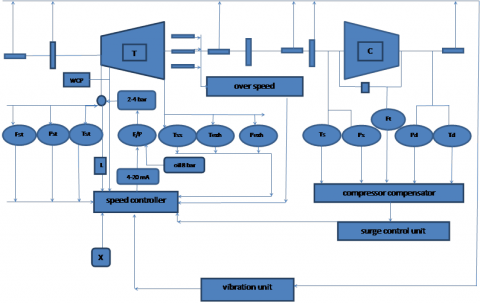Anti-surge protection system for compressors - I
This is the first of a three-part series by the author. This article explains surge phenomena and discusses why the anti-surge protection system is a very important part of a compressor.

Surge
It is a phenomena accompanied by centrifugal compressors having continuous flow rate, gas path inside compressor flows having an acceptable value of eddies and vortices but if these eddies and vortices exceeded the acceptable design limit that case will be called rotating stall and flow separation will take place decreasing static pressure causing reversal gas flow leading to high temperature and noise due to friction taking place between gas and stationary parts of compressor.
Flow reversal takes place as discharge pressure increases relatively compared to decrease of static pressure of suction by which this static pressure is the potential force that moves the gas inside the compressor while the dynamic pressure is the kinetic energy converted to pressure energy in diffuser due to work done by compressor on compressed gas as a compression process.
Blockage of downstream
In case of blockage in downstream of compressor or blockage in certain stage of compressor, this can cause a hazard effect on compressor performance as it leads to severe surge condition as follows.
1) Rapid rise in discharge pressure of compressor to a value higher than normal value.
2) Reversal flow of compressor back from downstream accompanied by high noise and vibrations amplitudes.
3) Increase in gas temperature due to friction of reversed gases and in path gases.
4) Decrease in suction pressure of compressor.
For a steam turbine operated compressor
- Increase in steam consumption of turbine.
- Increase in exhaust pressure and temperature of turbine due to excess steam consumption.
- Decreasing turbine efficiency and require more horse power (torque) in order to compress gases.
- Scope on condition monitoring
- Steam turbine out of control as steam consumption reached maximum.
- Control valve opening reach maximum.
- Compressor surging and unable to pass compressed gases to downstream due to blockage.
Remedies
- Opening anti-surge valves to circulate gases.
- Opening circulation (anti-choke) valve to circulate gases between different casing in multi stage and multi casing compressors.
- Placing safety relief valve at discharge line with a set point equal to the safe limit of compressor discharge pressure.
- Opening vent valve on compressor discharge to escape gas pressure to atmosphere.
These actions will take place before steam turbine reach maximum speed and over- speed trip where after over-speed trip the turbine will under come high thermal stresses and can reach higher critical speeds that should be overcome with an extra flow of steam which will not be found as boiler capacity will not cover it.
Also to overcome choking of compressor due to huge rise of rotating speed.
Poor response for anti-surge protection system
Anti-surge protection system is a very important part of compressor but it is not presented in anti-surge valves only but it contains a several devices that integrate all together to give an output which is the safe protection set-point for machine.
Anti-surge protection system has several points of control in other words its degree differs according to number of parameters measured and integrated processed data together to obtain the final result which will be applied as an action.
In the next part, the author discusses the parameters affecting the anti-surge control systems, the types of ASCS, explains their advantages, and elaborates their uses.
(The author is Turbomachinery Manager at Abu-Qir Fertilizers Company in Alexandria, Egypt. He has a Masters Degree in Mechanical Engineering.)